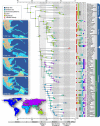Tectonic collision and uplift of Wallacea triggered the global songbird radiation
- PMID: 27575437
- PMCID: PMC5013600
- DOI: 10.1038/ncomms12709
Tectonic collision and uplift of Wallacea triggered the global songbird radiation
Abstract
Songbirds (oscine passerines) are the most species-rich and cosmopolitan bird group, comprising almost half of global avian diversity. Songbirds originated in Australia, but the evolutionary trajectory from a single species in an isolated continent to worldwide proliferation is poorly understood. Here, we combine the first comprehensive genome-scale DNA sequence data set for songbirds, fossil-based time calibrations, and geologically informed biogeographic reconstructions to provide a well-supported evolutionary hypothesis for the group. We show that songbird diversification began in the Oligocene, but accelerated in the early Miocene, at approximately half the age of most previous estimates. This burst of diversification occurred coincident with extensive island formation in Wallacea, which provided the first dispersal corridor out of Australia, and resulted in independent waves of songbird expansion through Asia to the rest of the globe. Our results reconcile songbird evolution with Earth history and link a major radiation of terrestrial biodiversity to early diversification within an isolated Australian continent.
Figures

References
-
- Gill F. B. & Donsker D. IOC World Bird List (v. 5.2) http://www.worldbirdnames.org (2015).
-
- Mayr G. The age of the crown group of passerine birds and its evolutionary significance—molecular calibrations versus the fossil record. Syst. Biodivers. 11, 7–13 (2013).
Publication types
MeSH terms
Associated data
Grants and funding
LinkOut - more resources
Full Text Sources
Other Literature Sources

